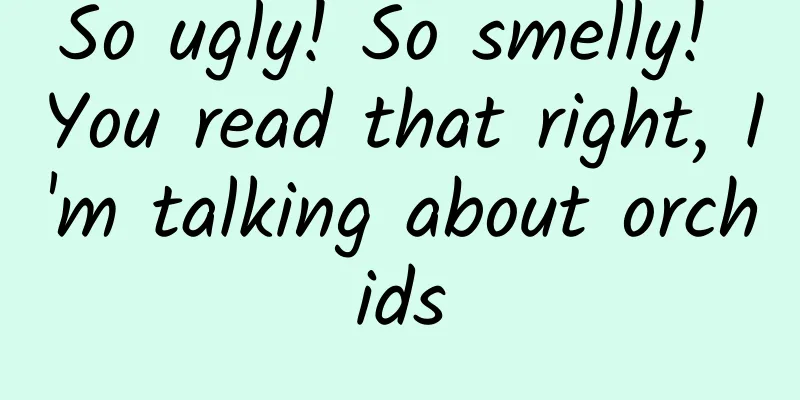So ugly! So smelly! You read that right, I'm talking about orchids

|
Everyone is familiar with orchids, such as this one: Cymbidium goeringii, source of the image see watermark What, you're not familiar with it? Then take a look at this: The back of the 1-cent coin of the fifth set of RMB, image source: cbpm As one of the top ten famous flowers in China, orchids give people the impression of being noble and elegant, or gorgeous and fragrant. In short, they are very beautiful images. However, today we are not going to appreciate the beauty of orchids, but to dig into the "dark" history of orchids, which is guaranteed to subvert your traditional impression of them. 01 It’s so ugly, is it really an orchid? Orchids are a general term for plants in the Orchidaceae family, one of the two major flowering plant families (the other is Asteraceae), and the orchid family is very large. There are currently about 28,000 recognized orchid species, and if you include the horticultural varieties cultivated by horticulturists, the number is even greater. Orchids in Ernst Haeckel's hand-painted paintings, source: Wikipedia The most significant feature of these orchids is that their flower structures are complex and varied. Usually, orchid flowers are composed of petals, sepals, stamens, ovaries, and styles. Among them, petals are often specialized to form some special structures, such as the lip (the lip is the most variable structure of orchids). Schematic diagram of orchid structure, picture source see watermark The rich structural changes give orchids a variety of flower shapes, and their flowers are almost all pleasing to the eye and pleasing to the eye. However, there are exceptions to everything. A new orchid discovered last year (yes, a new species discovered last year) looks like this: A new orchid species discovered last year. Image source: Reference [1] Is it different from the orchids you imagine? This new member of the orchid family is called Gastrodia agnicellus. It likes shade and grows in the humid evergreen forests of Madagascar. It is not easy to find it because this orchid grows epiphytically at the base of the tree or in the humus. The whole plant is almost completely covered by fallen leaves and humus, and only a small part of it will be briefly exposed to the ground when it blooms or bears fruit. Gastrodia agnicellus whole plant and flowers, image source: reference [1] Since they don't see light all year round and don't need to photosynthesize, leaves are naturally useless to them, so they don't grow leaves at all. Without leaves, they can't be self-sufficient in nutrition, so this orchid needs to rely on specific mycorrhizae to supply nutrients throughout its life cycle. Looking at their flowers, the bell-shaped sepals are fused together, the color is orange-brown, and the texture is very fleshy. It looks like it has rotted and smelled, which is very consistent with the living environment (after all, it lives in humus). However, such a flower can actually emit a musk rose-like scent? This... is really a bit of a contrast. 02 Orchids can also smell meat, but it's rotten meat It may not look pretty, but at least Gastrodia agnicellus has a nice scent, which is not the case with some orchids. Yes, I'm talking about you, Bulbophyllum echinolabium. Bulbophyllum spinulosum, image source: Wikipedia The spinulose lipped orchid is a member of the genus Bulbophyllum. Wild plants grow on tree trunks in the primeval forests of Indonesia and are epiphytic orchids. Epiphytic orchids refer to orchids that grow on tree trunks or rocks. They absorb water and minerals from the air through aerial roots and do not rely on soil for growth. For example, the familiar Phalaenopsis aphrodite Rchb. f. belongs to this group. Phalaenopsis, picture source see watermark Perhaps because the competition pressure of "attracting bees and butterflies" by scent is too great (after all, there are too many plants that do this), the spiny-lipped Bulbophyllum has found a new way to attract flies (and other scavenging insects) that live by smell to help pollinate. Think about the places where flies are active... you can imagine how notorious the "flower fragrance" of the spiny-lipped Bulbophyllum is. They give off the stench of rotting corpses (some describe it as the smell of stinky salted fish), and combined with their dark pink flowers and scarlet, furry lip petals, they really do look a bit like a piece of rotten meat, no wonder so many scavenging insects are fooled. The hairy lip of the spinulose pod, see the watermark for the source of the picture 03 Born to be a scam artist If the scary appearance and foul smell are only the problems of individual members, then the following point can be said to be a common "black spot" of many orchid members: that is, many orchids are habitual fraudsters. According to statistics, more than one-third of orchids use deceptive means to induce insects (and other pollinating animals) to pollinate them without providing any actual reward[2]. In order to deceive insects, orchids go to great lengths to constantly adjust the color, shape and smell of their flowers just to get free labor. In fact, the most common relationship between plants and pollinating animals is mutualism. We are very familiar with this model. The most common one is that animals pollinate plants and plants provide nectar as a reward. Carpenter bees collect pollen from Epiphyllum spp. Image source: Wikipedia Deceptive orchids often take advantage of existing pollination relationships, or of insects' mating, egg-laying, nest-building and other behaviors, to play with "naive" insects. The main strategies used by "cheater" orchids to cheat include food deception, sexual deception, oviposition site mimicry and habitat mimicry. Let's enumerate the crimes of orchids below. Foodborne deception Food-based deception is easy to understand: orchids send signals to insects (through smell, color, etc.) that there is nectar here, and when the insects are busy completing their pollination work, they find that they have been deceived and there is no reward at all. Many members of the Cypripedium genus are well versed in this, such as C. plectrochilum. Cypripedium sepalense, picture source see watermark Sexual deception Sexual deception is when orchids disguise themselves as female insects (by emitting fake female insect pheromones and morphological signals) to lure male insects to mate, while actually pollinating the orchids. For example, some members of the genus Ophrys have labellums that look very similar to female bees of certain species, thereby tricking male bees into pollinating. Ophrys speculum mimics a female bumblebee (Dasyscolia ciliata) to attract male bumblebees for pollination. Image source: Wikipedia Spawning site mimicry Orchids that use oviposition mimicry will disguise themselves as suitable oviposition sites (such as decaying animal carcasses, feces, and fungal fruiting bodies) based on the oviposition behavior of insects, tricking insects into coming and helping them complete pollination. Some members of the genus Paphiopedilum are good at this, such as Paphiopedilum purpuratum, which mimics the oviposition sites of the black-banded hoverfly (Episyrphus balteatus de Geer) to trick female flies into laying eggs and pollinating them. Purple-veined Paphiopedilum, image source: China's Most Beautiful Wild Flowers 200, Chongqing University Press In addition to the typical deceptive behaviors mentioned above, orchids can also mimic the alarm pheromones of aphids, emit volatile substances from plant green leaves, etc., which can be said to be the maximum deceptive skills. Uh... I didn't expect the Orchid family to be so chaotic. I want to ask Orchid, how many surprises do you have that I don't know about? References: [1] Hermans J. GASTRODIA AGNICELLUS[J]. Curtis's Botanical Magazine, 2020, 37(3). [2] Ren Zongxin, Wang Hong, Luo Yibo. Deceptive pollination in orchids[J]. Biodiversity Science, 2012, 20(03):270-279. [3] Agricultural Dictionary Editorial Committee. Agricultural Dictionary: [M]. Beijing: China Agriculture Press, 1998 [4] Christopher Brickell. Encyclopedia of Garden Plants and Flowers of the World [M]. Zhengzhou: Henan Science and Technology Press, 2005 [5] Ma Xiaokai. Evolution of deceptive pollination system in Paphiopedilum, Orchidaceae[D]. University of Chinese Academy of Sciences, 2015. [6] Liu Xiaolin, Meng Xiangzhi. A review of the adaptation mechanism between flowers and pollinators[J]. Biology Teaching, 2019, 44(01):62-64. Review expert: Ran Hao, well-known popular science writer. END Tadpole Musical Notation original article/reprint please indicate the source Editor/Heart and Paper |
<<: Cucumbers are obviously green, so why are they called cucumbers?
>>: Down jacket warning map: More than three quarters of the country needs to wear down jackets
Recommend
50 financial secrets to comprehensively improve your wealth!
Money is not everything, but it can solve most pr...
How to tap into demand? 3 methods to help you discover your needs!
Many product managers are particularly distressed...
Details of ZUK phone revealed, is it going to be an Android version of iPhone?
"If the ZUK phone and the next generation iP...
Liu Guanqi's Spoken English Course 3.0 Upgraded Version
: : : : : : : : : : : : : : : : : : : : : : : : : ...
Chinese toon is delicious, but you may be worried about nitrite poisoning! Here's a way to solve it
Another spring has come, and Chinese toon has beg...
Recently! My body suddenly became itchy, red and swollen for no apparent reason. Read this article! (It’s not a mosquito)
Who in my family would understand? While waiting ...
Taking "Tencent Game Manager" as an example, let's talk about user growth!
1. Market Background By thinking about and analyz...
Statistical analysis of mobile game players’ payment behavior in 2014
Recently, a mobile game trading platform released...
TrendForce: In April 2023, the average price of battery-grade lithium carbonate in China fell to RMB 198,000 per ton, a monthly drop of 39%.
According to TrendForce's official WeChat acc...
Li Lihui: Digital RMB will not replace WeChat and Alipay at least in the next ten years
Can the digital RMB replace Alipay and WeChat Pay...
Tik Tok "Enterprise Certification" is online, all issues are explained!
The Douyin "Enterprise Certification" t...
A girl was suspected to have been secretly drugged by her male companion while eating in a restaurant. After the waiter found out, he cleverly changed the water to resolve the situation!
[Girl suspected of being secretly drugged by her ...
Are luxury goods suitable for TikTok marketing? ?
Last week, TikTok officially announced that its g...
My boss gave me a 1k budget for the event, but I achieved the results of a 100k budget
The work of operators can be said to be inseparab...
Xiamen’s latest settlement policy in 2022: Will Xiamen cancel restrictions on settlement?
The People's Government of Xiamen City issued...









